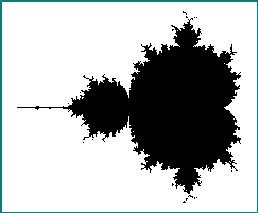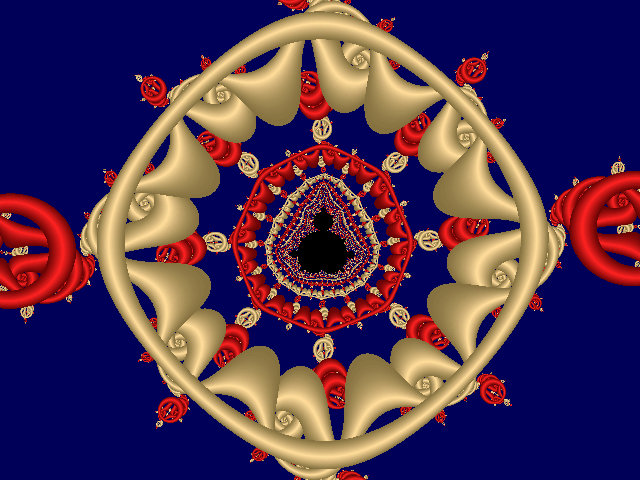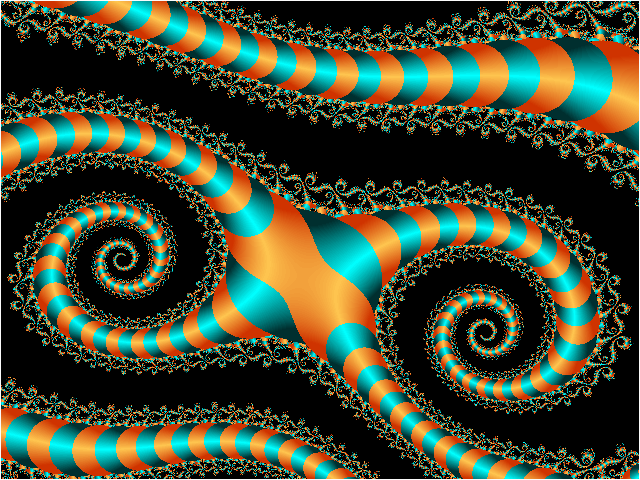![]()
The Julia and Mandelbrot Sets
Ancient History
The first significant work on "Julia Sets" was done by Gaston Julia in 1917 while he was in a hospital recovering from injuries received during the first world war. Much of the initial work on the properties of these sets was done by Julia and Pierre Fatou, a contemporary and rival of Julia, in the 1920s.
One of their major achievements was to show that there are two quite different types of Julia sets. The first is a "connected" set which covers a finite area on the X-Y plane; the second is a "not-connected", or NC, set which consists merely of a cloud of discrete points in a region of the X-Y plane. This cloud of points was originally called a "Fatou dust" by a few European authors. It is now called a "Cantor dust set" by almost everyone. Georg Cantor created the foundations of modern set theory in the 1800s. He had done some earlier work on this type of set.
All of this was done without benefit of computers.
Their results were of mild interest to a small group of pure mathematicions,
and were ignored by everyone else.
![]()
Recent History
In the 1970s, an applied mathematician, Benoit Mandelbrot, working at the IBM Research Laboratory, did some computer simulations for these sets on the reasonable assumption that, if you wanted to prove something, it might be helpful to know the answer ahead of time. Mandelbrot had been one of Julia's students in 1945, and he was familiar with the papers of both Julia and Fatou.
IBM had the best computers available, and a policy of letting research staff members have lots of free computer time to work on anything in which they were interested. Of course, they were also expected to do something useful occasionally.
In 1979 Mandelbrot produced a computer generated image of what later became known as the "Mandelbrot Set". This set covers a region in the complex C-plane with the property that values of C within this set, or on it's boundary, result in "Connected Julia Sets", and values of C outside the Mandelbrot set produce NC Julia sets that are just clouds of discrete points, or Cantor dust sets.
The boundary of this set is very complex. Extending from the perimeter of the large central area are several large and and many small circular bumps, plus numerous thin filaments, or "dendrites", which branch out in irregular shapes and contain small islands shaped like miniature versions of the main section.
Some people find this set rather ugly. But zooming in on small regions around its boundary, but outside the set, can produce an enormous number of interesting patterns which can be used to create beautiful images when combined with an appropriate coloring gradient.

In the early 1980s John Hubbard at Cornell University and Adrien Douady at the University of Paris showed that all of the islands surrounding the set were connected. This is not at all obvious by looking at a computer image, even under high magnification. They also named the set after Mandelbrot.
The M-set can be used as a guide to the selection of the constant term in the Julia sets. By far the most interesting images are obtained for Julia sets having constants in the region near the M-set boundary, both inside and outside the set itself.
In 1982, Mandelbrot published a book entitled "The Fractal Geometry of Nature", W. H. Freeman & Co. This was a seminal event in the history of fractals, as much from a public relations standpoint as for its mathematical content. It created considerable interest in the study of these objects, among the general public as well as among mathematicians.
Powerful PCs were just becoming widely available at
a reasonable cost. The use of computer simulation, combined with computer
graphics to create beautiful images, generated far more interest than is
usually the case for developments in mathematics. Computer "art" became
popular, and a number of exhibits of Julia and Mandelbrot set images were
shown at art museums in this country and Europe in the mid 1980s.

![]()
Some Fractal Pictures



Fast access to the
following different links